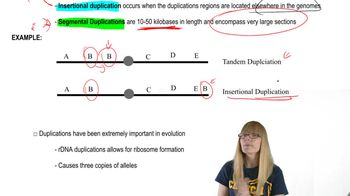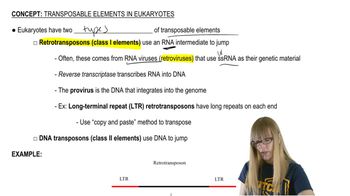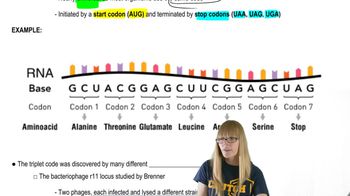Table of contents
- 1. Introduction to Genetics51m
- 2. Mendel's Laws of Inheritance3h 37m
- 3. Extensions to Mendelian Inheritance2h 41m
- 4. Genetic Mapping and Linkage2h 28m
- 5. Genetics of Bacteria and Viruses1h 21m
- 6. Chromosomal Variation1h 48m
- 7. DNA and Chromosome Structure56m
- 8. DNA Replication1h 10m
- 9. Mitosis and Meiosis1h 34m
- 10. Transcription1h 0m
- 11. Translation58m
- 12. Gene Regulation in Prokaryotes1h 19m
- 13. Gene Regulation in Eukaryotes44m
- 14. Genetic Control of Development44m
- 15. Genomes and Genomics1h 50m
- 16. Transposable Elements47m
- 17. Mutation, Repair, and Recombination1h 6m
- 18. Molecular Genetic Tools19m
- 19. Cancer Genetics29m
- 20. Quantitative Genetics1h 26m
- 21. Population Genetics50m
- 22. Evolutionary Genetics29m
11. Translation
The Genetic Code
Problem 31g
Textbook Question
M. Klemke et al. (2001) discovered an interesting coding phenomenon in which an exon within a neurologic hormone receptor gene in mammals appears to produce two different protein entities ( and ALEX). Following is the DNA sequence of the exon's end derived from a rat.
5'-gtcccaaccatgcccaccgatcttccgcctgcttctgaagATGCGGGCCCAG
The lowercase letters represent the initial coding portion for the protein, and the uppercase letters indicate the portion where the ALEX entity is initiated. (For simplicity, and to correspond with the RNA coding dictionary, it is customary to represent the coding (non-template) strand of the DNA segment.)
Are there any evolutionary advantages to having the same DNA sequence code for two protein products? Are there any disadvantages?
 Verified step by step guidance
Verified step by step guidance1
<span>1. **Understanding the Concept of Alternative Splicing**: In genetics, alternative splicing allows a single gene to code for multiple proteins. This process involves the inclusion or exclusion of certain exons during mRNA processing, leading to different protein products from the same DNA sequence.</span>
<span>2. **Analyzing the DNA Sequence**: The given DNA sequence has lowercase and uppercase letters indicating different coding regions. The lowercase letters represent the initial coding portion, while the uppercase letters indicate where the ALEX protein entity is initiated.</span>
<span>3. **Evolutionary Advantages**: Having the same DNA sequence code for two protein products can increase genetic diversity without the need for additional genetic material. This can lead to more efficient use of the genome, allowing organisms to adapt to different environments or functions with minimal genetic changes.</span>
<span>4. **Potential Disadvantages**: The complexity of regulating multiple proteins from a single gene can lead to errors in splicing or expression. Misregulation can result in diseases or dysfunctional proteins, which could be detrimental to the organism.</span>
<span>5. **Conclusion**: The ability to produce multiple proteins from a single gene is a double-edged sword, offering both evolutionary benefits in terms of adaptability and efficiency, and potential risks related to regulatory complexity and error susceptibility.</span>
Recommended similar problem, with video answer:
 Verified Solution
Verified SolutionThis video solution was recommended by our tutors as helpful for the problem above
Video duration:
1mPlay a video:
Was this helpful?
Key Concepts
Here are the essential concepts you must grasp in order to answer the question correctly.
Alternative Splicing
Alternative splicing is a process by which a single gene can produce multiple protein isoforms by including or excluding certain exons during RNA processing. This mechanism allows for greater diversity in protein function and regulation, enabling organisms to adapt to various environmental challenges. In the context of the question, the ability of a single exon to code for two different proteins exemplifies how alternative splicing can enhance genetic versatility.
Recommended video:
Guided course

Alternative DNA Forms
Gene Duplication and Divergence
Gene duplication is a key evolutionary mechanism where a segment of DNA is copied, resulting in two identical genes. Over time, these duplicated genes can diverge in function, leading to the evolution of new traits or functions. The phenomenon described in the question may suggest that the ability to produce two proteins from the same sequence could be a result of evolutionary pressures favoring genetic redundancy and functional specialization.
Recommended video:
Guided course

Duplications
Evolutionary Trade-offs
Evolutionary trade-offs refer to the balance between advantages and disadvantages that arise from certain genetic traits. While producing multiple proteins from the same DNA sequence can provide flexibility and adaptability, it may also lead to resource allocation issues or potential misregulation of protein expression. Understanding these trade-offs is crucial for evaluating the evolutionary significance of such genetic phenomena.
Recommended video:
Guided course

Eukaryotic Transposable Elements

 11:43m
11:43mWatch next
Master The Genetic Code with a bite sized video explanation from Kylia Goodner
Start learningRelated Videos
Related Practice


